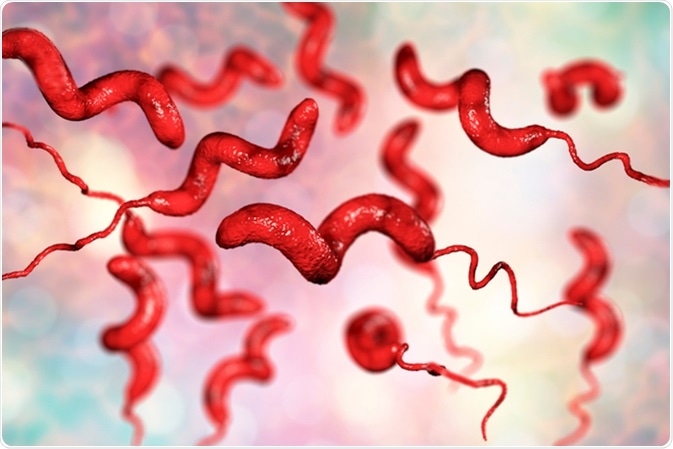Campylobacteriosis is the term used to refer to the group of infectious foodborne diseases caused by several species of Campylobacter.

Campylobacter bacteria, C. jejuni, C. fetus, Gram-negative S-shaped motile bacteria the causative agent of food-borne infection campylobacteriosis, 3D illustration. Image Credit: Kateryna Kon / Shutterstock
These are Gram negative curved pathogens. It is found in most countries of the world and is transmitted from poultry and cattle meat or milk, which in turn is infected by contact with birds. Raw/undercooked/unpasteurized infected milk and meat or drinking water is responsible for human infection, but contact with animals around the house and farm, especially with puppies, may also cause infection to spread. Hygienic food handling is paramount in preventing campylobacteriosis. These organisms are quickly inactivated by heating the contaminated food, but not by freezing.
While Campylobacters have been recognized to cause animal disease from 1909, it was only in 1980 that human infection was described. Over the last decade the number of human cases has shot up by 14% principally by contaminated poultry meat, and the EU member states may have anywhere from 2-20 million cases annually.
Several different strains are known to cause human disease, mainly C. jejuni and C. coli. Campylobacters have flagella and adherence factors, which enable them to stick to the intestinal mucosa. This in turn promotes small bowel colonization followed by migration to the colon, which is their primary location. Invasion of the bowel wall is facilitated by toxin production, which reduces intestinal absorption. The bacterium resists destruction by gastric acids and bile salts to reach the jejunum and beyond.
https://www.youtube.com/watch?v=V3QS_EgEYlk
Risk Factors
The risk of spread of infection varies greatly between abattoirs, and with age, season, time of day when the meat is slaughtered and processed, and the performance of flock depopulation. Host immunity, socioeconomic status, and travel are also important factors.
The indiscriminate use of antibiotics in livestock husbandry to enhance profitable animal growth and prevent or control infections is now being increasingly recognized as a key factor in the emergence of antibiotic-resistant Campylobacter strains.
Clinical Features
Campylobacteriosis is associated with the following diseases and post-infectious sequelae or complications:
- Gastroenteritis with acute infection, which manifests with acute diarrhea, fever, weight loss, and abdominal cramps for about 6 days on average
- Inflammatory bowel disease especially with C. concisus and C. jejuni
- Gastroesophageal reflux disorder and Barrett’s esophagus may be due to C. concisus colonization, and it is also associated with increased IL-18 production, which is an inflammatory cytokine and also linked to carcinogenesis.
- Severe periodontal disease and gingivitis may be caused by C. rectus, C. gracilis, C. showae, and C. concisus
- Functional dyspepsia is twice as common following Campylobacter infection
- Colorectal cancer, though the association is weak, is shown to be linked to a specific microbial profile featuring Campylobacters, among others, which may result in gut dysbiosis, a known risk factor for this cancer
- Celiac disease, a digestive disorder with impairment of function in response to gluten exposure, is thought to be associated with Campylobacteriosis, because of the 3.5-fold higher rate of this disease (0.15 per 100,000 person-years) in infected compared to unexposed individuals
Post-infectious sequelae also include the following:
- Guillain-Barre syndrome (GBS) is a neurologic condition in which there is progressive symmetrical limb weakness, cranial or somatic peripheral neuropathy, and often accompanying hyporeflexia. It may be one of two types: acute motor axonal neuropathy (AMAN) and acute inflammatory demyelinating polyneuropathy (AIDP). It is considered to be due to C. jejuni infection, which causes the development of cross-reacting antibodies against bacterial lipooligosaccharide (LOS) and gangliosides in human nervous tissue, such as the GM1 ganglioside.
- Miller Fisher syndrome is a GBS variant with areflexia, ataxia and paralysis of the ocular muscles of acute onset due to the development of anti-GQ1b antibodies after exposure to LOS
- Brain abscesses and meningitis may occur with C. fetus, but is rare and usually only seen in immunocompromised adults.
- Bacteremia and sepsis may occur especially with C. jejuni, C. coli, and C. fetus.
- Cardiovascular disease, such as endocarditis and myocarditis may occur with C. jejuni and C. fetus, but are relatively less common than with Shigella/Salmonella infections; they may be due to the bacterial invasion of heart cells and toxic reactions, or to T-cell activation and the production of circulating immune complexes.
- Reactive arthritis occurs in the thirties or forties following a genitourinary or gastrointestinal infection, causes pain in the knees and ankles, also in the eyes and other systems, such as the gut and genitourinary systems. The symptoms begin about a month after and resolve within a year after the primary infection in most cases.
- Reproductive tract complications, such as septic abortion and neonatal sepsis may arise.
Outcome
Most patients recover spontaneously and require only replacement of fluid and electrolytes. Antibiotics may be required in severe infection, chiefly macrolides, tetracyclines and fluoroquinolones, but resistance is rapidly emerging, and may require stronger antibiotics.
Further Reading
Last Updated: Jun 28, 2019